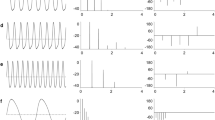Abstract
Rhamphichthys rostratus (L.) emits brief pulses (2 ms) repeated very regularly at 50 Hz. The electric organ shows a heterogeneous distribution of the electrocyte tubes and the occurrence of three electrocyte types (caudally innervated, rostrally innervated and marginallycaudally innervated). In the sub-opercular region the electric organ consists of a pair of tubes containing only caudally innervated electrocytes. At the abdominal region the EO consists of three pairs of tubes. Each pair contains one of the described electrocyte types. The number of electrocyte tubes increases toward the tail to reach nine or ten pairs in the most caudal segments. In the intermediate region most tubes contain doubly innervated electrocytes except the ventral pair that contains caudally innervated electrocytes. The caudal 25% contains exclusively caudally innervated electrocytes. The electric organ discharge consists of five wave components (V1 to V5). Electrophysiological data are consistent with the hypothesis that V1 results from the activity of the rostral faces of rostrally innervated electrocytes. V2 results from the activities of rostral faces of marginally-caudally innervated electrocytes while V3 results from the activities of caudal faces of most electrocytes. Curarization experiments demonstrated that V4 and V5 result from action potential invasion and are not directly elicited by neural activity.
Similar content being viewed by others
Abbreviations
- AEN1:
-
anterior electromotor nerve 1
- AEN2:
-
anterior electromotor nerve 2
- BMB:
-
boraxic methylene blue
- CIE:
-
caudally innervated electrocytes
- EMF:
-
electromotive force
- EO:
-
electric organ
- EOD:
-
electric organ discharge
- I :
-
current amplitude
- MCIE:
-
marginally-caudally innervated electrocytes
- MT:
-
medial tubes
- PEN:
-
posterior electromotor nerve
- R n :
-
internal impedance
- RIE:
-
rostrally innervated electrocytes
- Rl:
-
load resistor
- SAT:
-
short abdominal tubes
- V :
-
voltage amplitude
References
Albe-Fessard D, Martins-Ferreira H (1953) Rôle de la commande nerveuse dans la synchronization du fonctionnement des éléments de l'organe électrique de gymnote, Electrophorus electricus L. J Physiol (Paris) 45:533–546
Bass AH (1986) Electric organs revisited. Evolution of a vertebrate communication and orientation organ. In: Bullock TH, Heiligenberg W (eds) Electroreception. Wiley, New York Chistester Brisbane Toronto Singapore, pp 13–70
Bennett MVL (1971) Electroreception. In: Hoar WS, Randall DJ (eds) Fish physiology, vol 5. Academic Press, New York, pp 493–574
Bennett MVL, Grundfest H (1959) Electrophysiology of electric organ in Gymnotus carapo. J Gen Physiol 42:1067–1104
Bullock TH (1984) Understanding brains by comparing taxa. Perspect Biol Med 27:510–524
Bullock TH (1986) Significance of findings on electroreception for general neurobiology. In: Bullock TH, Heiligenberg W (eds) Electroreception. Wiley, New York Chistester Brisbane Toronto Singapore, pp 651–672
Bullock TH (1993) How are more complex brains different? One view and agenda for comparative neurobiology. Brain Behav Evol 41:88–96
Caputi A, Macadar O, Trujillo-Cenóz O (1989) Waveform generation in Gymnotus carapo. III. Analysis of the fish body as an electric source. J Comp Physiol A 165:361–370
Caputi A, Suva A, Macadar O (1993) Electric organ activation in Gymnotus carapo: spinal origin and peripheral mechanisms. J Comp Physiol A 173:227–232
Coates CW, Cox RT, Rosemblith WA, Brown MB (1940) Propagation of the electric impulse along the organs of the electric eel, Electrophorus electricus (Linnaeus). Zoologica 25:249–256
Donaldson PEK (1958) Electronic apparatus for biological research. Butterworth, London
Ellis MM (1913) The gymnotoid eels of tropical America. Mem Carnegie Mus 6:109–195
Fink SV, Fink W (1981) Interrelationships of the ostariophysan fishes (Teleostei). Zool J Linn Soc 72:297–353
Gayet M, Meunier J (1991) Première découverte de Gymnotiformes fossiles (Pisces, Ostariophysi) dans le Miocène supérieur de Bolivie. C R Acad Sci Paris 313:471–476
Hopkins CD (1983) Function and mechanisms in electroreception. In: Northcutt RG, Davis RE (eds) Fish neurobiology, vol 1. Ann Arbor Univ of Michigan Press, pp 215–259
Hopkins CD (1988) Neuroethology of electric communication. Annu Rev Neurosci 11:497–535
Ihering R von (1907) Os peices de agua doce do Brazil. Rev Mus Paulista 7:258–336
Kramer B, Tautz J, Markl H (1981) The electric organ discharge sound response in weakly electric fish. J Comp Physiol 143:435–441
Lissmann HW, Schwassmann HO (1965) Activity rhythm of an electric fish Gymnorhamphichthys hypostomus. Z Vergl Physiol 51:153–171
Lorenzo D, Velluti JC, Macadar O (1988) Electrophysiological properties of abdominal electrocytes in the weakly electric fish Gymnotus carapo. J Comp Physiol A 162:141–144
Lorenzo D, Sierra F, Silva A, Macadar O (1990) Spinal mechanisms of electric organ discharge synchronization in Gymnotus carapo. J Comp Physiol A 167:447–452
Macadar O (1993) Motor control of waveform generation in Gymnotus carapo. J Comp Physiol A 173:728–729
Macadar O, Lorenzo D, Velluti JC (1989) Waveform generation of the electric organ discharge in Gymnotus carapo. II. Electrophysiological properties of single electrocytes. J Comp Physiol A 165:353–360
Mago-Leccia (1978) Los peces de la familia sternopygidae de Venezuela. Acta Cient Venez 29:1–89
Schwassmann HO (1976) Ecology and taxonomic status of different geographic populations of Gymnorhamphichthys hypostomus Ellis (Pisces, Cypriniformes, Gymnotoidei). Biotropica 8:25–40
Szabo T (1960) Quelques observations sur l'innervation de l'organe électrique de Gymnotus carapo. Arch Anat Microsc Morphol Exp 49:89–92
Szabo T (1961) Les organes électriques de Gymnotus carapo. Proc K Ned Akad Wet 64:584–586
Trujillo-Cenóz O, Echagüe JA (1989) Waveform generation of the electric organ discharge in Gymnotus carapo. I. Morphology and innervation of the electric organ. J. Comp Physiol A 165:343–351
Trujillo-Cenóz O, Echagüe JA, Macadar O (1984) Innervation pattern and electric organ discharge waveform in Gymnotus carapo. J Neurobiol 15:273–281
Author information
Authors and Affiliations
Rights and permissions
About this article
Cite this article
Caputi, A., Macadar, O. & Trujillo-Cenóz, O. Waveform generation in Rhamphichthys rostratus (L.) (Teleostei, Gymnotiformes). J Comp Physiol A 174, 633–642 (1994). https://doi.org/10.1007/BF00217384
Accepted:
Issue Date:
DOI: https://doi.org/10.1007/BF00217384




